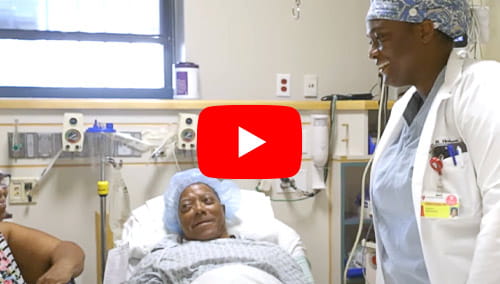
Brain Stem Tumors
University Hospitals Seidman Cancer Center Offers the Latest Medical Advancements in Treating Brain Stem Cancer
If you or a loved one has been diagnosed with brain stem cancer, we understand your concerns and fears. Our fellowship-trained cancer specialists at UH Seidman Cancer Center work closely with specialists from University Hospitals Neurological Institute's Brain Tumor and Neuro-Oncology Center to offer a highly specialized approach to diagnosing, treating and managing brain stem cancer.
Your health is important. Make an appointment today.
Offering in-person, video and telephone visits. Call todayto see which option is right for you. 216-844-3951
Learn more about virtual visits
What is Brain Stem Cancer?
The brain stem, which is in the lowest part of the brain and connects the brain with the spinal cord, controls a number of vital body functions, including body temperature, blood pressure, breathing, hunger and thirst. The brain stem is also responsible for transmitting all the signals from the brain to other areas of the body.
Tumors of the brain stem can be difficult to treat. The most common type of brain stem tumor is brain stem glioma. A glioma is a type of tumor that develops from glial cells (supportive cells that surround nerve cells) within the brain stem. Most brain stem gliomas originate in a subtype of glial cells called astrocytes – these gliomas are also called astrocytomas.
Although brain stem gliomas are the most common type of brain stem cancer found in adults, they occur much more frequently in children and younger adults (people under the age of 20) and account for only about two percent of total adult brain tumors. Other types of rare brain stem tumors seen in adults include:
- Atypical Teratoid Rhabdoid Tumor (ATRT): a rare, fast-growing cancerous tumor of the brain stem and spinal cord
- Hemangioblastoma: a rare benign vascular tumor that develops in the brain stem and spine; although they are benign, hemangioblastomas can cause significant neurological problems
What Causes Brain Stem Tumors?
In most cases, the cause of brain stem glioma is unknown. However, a few rare genetic conditions, including as neurofibromatosis type 1, may increase a person’s chance of developing a brain stem glioma.
Most atypical teratoid/rhabdoid tumors are caused by a defective gene (SMARCB1) that normally signals proteins to inhibit tumor growth.
Hemangioblastomas occur sporadically and without a known cause. However, some incidences of hemangioblastoma are connected to von Hippel-Lindau (VHL) syndrome, an inherited condition in which abnormal tumor growth occurs in certain parts of the body.

What Are Brain Stem Tumor Symptoms?
Depending on the size, type and location of the brain stem tumor, symptoms may include:
- Seizures
- Endocrine problems (diabetes and/or hormone regulation)
- Not being able to close eyes or double vision
- Headaches
- Paralysis of the nerves and muscles of the face or one half of the body
- Facial weakness and drooping
- Difficulty talking
- Respiratory changes
- Increased intracranial pressure (ICP)
- Hearing loss
- Personality changes
- Trouble swallowing or gagging while eating
- Weakness in the arms and legs, clumsiness or wobbliness, and difficulty walking or standing
- Nausea and vomiting
Brain Stem Tumor Prognosis
Brain stem cancer prognosis is highly dependent on a number of factors, including the tumor type and grade, the patient’s age and overall health when diagnosed, and the patient’s response to treatment. The good news is that the survival rates for adults with brain stem cancer are improving as researchers and clinicians continue to explore new technologies and improve available treatment options.
The brain stem glioma average survival for adults is approximately 44 to 74 months following diagnosis. However, for patients with a brain stem glioma that is considered low-grade and focal (limited to a specific area), long-term survival is possible with surgery and radiation therapy. The relative 5-year survival rate for patients diagnosed with an atypical teratoid rhabdoid tumor is 32.2 percent.
For patients who do not have VHL syndrome, hemangioblastoma long-term outcomes are very good when surgical extraction of the tumor can be achieved, which is usually the case. The prognosis for hemangioblastoma patients who have VHL syndrome is generally not as good because those patients develop multiple tumors.
Treatment of Brain Stem Tumors
Utilizing some of the most advanced brain cancer treatments available and conducting groundbreaking clinical trials, UH Seidman Cancer Center’s physicians have established many innovations in treating various types of brain cancer. As such, our patients have access to advanced treatments and therapies sooner than those treated at most other hospitals.
Treatments for brain stem cancer include the following:
- Surgery
-
Surgery may be used in both the diagnosis and treatment of brain stem cancer. Surgical removal of the tumor helps reduce pressure on nearby parts of the brain. Surgery may be followed by chemotherapy or a combination of chemotherapy and radiation therapy.
Working closely with specialists from University Hospitals Neurological Institute’s Brain Tumor and Neuro-Oncology Center, our fellowship-trained neurosurgeons utilize the latest advances in surgical intervention to treat brain cancer, including:
- Minimally invasive brain tumor surgery: This approach includes endoscopic techniques through which our neurosurgeons view detailed images of the patient’s brain using a small camera.
- Fluorescence-guided surgery: UH Seidman Cancer Center neurosurgeons have pioneered the use of special fluorescent markers (such as 5-ALA) to assist in precisely identifying the borders of tumors in order to help surgeons remove more of the tumor while minimizing risk to the brain.
- NeuroBlate®: This revolutionary laser interstitial thermal therapy destroys brain tumor tissue with a magnetic resonance imaging (MRI)-guided laser. Our hospital is one of only a handful in the world that offers this minimally invasive treatment, which can be used to treat brain tumors that were previously diagnosed as untreatable.
- Intraoperative MRI: With specialized intraoperative MRI suites, we use magnetic resonance imaging to track surgical progress in real-time.
- Radiation Therapy
-
Radiation therapy involves the use of high-energy x-rays or other types of radiation to kill cancer cells or prevent them from growing. Using a machine outside the body, external radiation therapy sends radiation directly toward the area of the tumor. Radiation therapy is often recommended after surgery and may be administered in combination with chemotherapy. For patients who cannot undergo surgery, radiation therapy and chemotherapy may be used as a primary treatment.
Among the innovative radiation technologies we use in the treatment of brain stem cancer is:
- GammaTile®: This surgically targeted radiation therapy involves the placement of a bioresorbable, flexible collagen tile within the brain immediately following tumor removal.
- Proton therapy: UH Seidman Cancer Center is the first hospital in Northeast Ohio to offer this innovative, powerful and technologically advanced therapy. Effective for both adults and children, proton therapy has less side effects than other forms of radiation therapy, resulting in better quality of life during treatment, while also reducing patient risk for the development of radiation-induced secondary cancers decades after treatment.
- Stereotactic Radiosurgery
-
Stereotactic radiosurgery is a type of radiation therapy used to treat brain stem tumors and other cancers when conventional surgery is not an option due to safety concerns. Stereotactic radiosurgery differs from traditional radiation therapy in that stereotactic radiosurgery involves the use of precisely focused radiation beams. Unlike traditional radiation therapy, stereotactic radiosurgery exposes very little if any normal tissue to radiation.
Stereotactic radiosurgery is often recommended after surgery and may be administered in combination with chemotherapy. For patients who cannot undergo surgery, stereotactic radiosurgery and chemotherapy may be used as a primary treatment.
Among the innovative stereotactic radiosurgery technologies we use in the treatment of brain stem cancer are:
- Gamma Knife®: An accurate form of stereotactic radiosurgery for the brain, this technology pinpoints a single area with numerous gamma radiation beams without damaging surrounding healthy tissue.
- Varian Edge™: This advanced, high-focus radiation beam radiosurgery system targets the DNA in cancer cells, destroying the cells. Unlike other radiosurgery systems that require the use of a rigid frame to secure a brain cancer patient’s skull during treatment sessions that can last several hours, Varian Edge delivers equally precise treatment without requiring a frame in as little as just a few minutes.
- Chemotherapy
-
Chemotherapy uses drugs to stop the growth of cancer cells, either by killing the cells or preventing their division.
- Targeted Drug Therapy
-
Targeted therapy is an approach to treatment that utilizes drugs to identify and attack specific cancer cells. In general, targeted therapies inflict less harm to normal cells than chemotherapy or radiation therapy.

Innovative Research Leads to New Opportunities in Care
University Hospitals is an affiliate of Case Western Reserve University School of Medicine, a nationally recognized leader in clinical research. UH Seidman Cancer Center currently conducts a number of clinical trials for patients with brain tumors, offering patients access to new and innovative therapies and treatment options.
Why Choose UH Seidman Cancer Center for Brain Stem Tumor Treatment?
Member of the Adult Brain Tumor Consortium, a consortium of 11 elite Centers of Excellence for brain tumors.
Part of the NCI-designated Case Comprehensive Cancer Center at Case Western Reserve University School of Medicine – one of an elite group of 53 comprehensive cancer hospitals nationwide.
The first stereotactic radiosurgery suite in Ohio to offer Gamma Knife® technology for malignant and benign brain tumors
The first hospital in Ohio to offer proton therapy – an innovative, technologically advanced cancer treatment
The first cancer center to offer GammaTile®, a form of radiation that dissolves in the patient’s brain after placement at the end of brain surgery
One of the leading centers in the country for minimally invasive (Laser Interstitial Thermotherapy) combined with immunotherapy
A Compassionate, Highly Trained, Multidisciplinary Team of Experts
Just as each patient is unique, we believe that cancer treatment should be customized to fit the individual. We offer patients a multidisciplinary team approach to care. This means all our cancer doctors, nurses and support staff collaborate and coordinate your care. Diagnosis and treatment decisions are based on our entire team’s expertise. Members of the team may include:
- Genetic counselors
- Medical geneticists
- Medical oncologists
- Nurse navigators
- Nurse practitioners
- Pathologists
- Radiation oncologists
- Radiologists
- Social workers
- Surgical oncologists
Furthermore, at UH Seidman Cancer Center, each patient’s case is presented at weekly tumor board meetings, where our team conducts a disease-specific tumor board review to ensure that all treatment options are considered.



